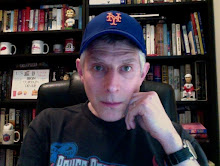OCTOBER 1974: Gerald Ford was two months into his abbreviated presidency. The Muhammad Ali-George Foreman boxing match in Kinshasa, Zaire -- known as the Rumble in the Jungle -- was set for Oct. 30.
Earthquake, in Sensurround!, starring Charleton Heston, Ava Gardner, Geneviève Bujold and Lorne Greene would strike America's movie theaters in November.
But something else was afoot, something far more subtle and pernicious, but to those of us of a particular bent: horrifically depressing.
 |
| Meh, before meh was even a thing. |
Fifty years ago this month, Major League Baseball ended the era of team-produced World Series programs, subbing out the often charming, definitely distinct and occasionally iconic locally-designed and produced magazines for more uniform, corporate and nationally available... blah.
Yes, this is entirely about judging these books by their covers. But you only get one chance to make a good first impression.
MLB's first cover art was a globe stand where the Earth is replaced baseball.
Inspired. Clever. Ooh. In other words, not good.
Who's playing in this series? Doesn't matter. And it wouldn't matter again for about 20 years and even then, well... feh.
Less than a decade earlier and from the same spherical starting point, the Los Angeles Dodgers had produced this bit of Project Gemini-inspired whimsy:
 |
| Truly out of this world. |
Now artistry was banished in favor of mass produced, mass market product. At least they were up front about it, more or less.
"'1974 World Series marks an all-time first,'" the publication self-referentially declared on its page 3. "Previously the two teams involved in a World Series each published a separate program. '1974 World Series' represents the first joint World Series program. It is designed to tell the story of this year's major league baseball season and features both the East and West Division champions of the two leagues."
Yay.
It's tempting to say at least some of this was in response to frugal Charles O. Finley, then-owner of the then-two time defending champion then-Oakland A's.The famously skin-flinty Finley just they year before had substantially just repurposed the team's joint scorecard and yearbook as its World Series program, slapping American League Champions on the top left, New York Mets beneath "Oakland A's" at the top right, and re-labeling the bottom right "1973 World Series Souvenir Scorecard & Program."
 |
| The regular season program |
 |
| The not-so-different World Series edition |
To be fair, the only somewhat less frugal Mets had repackaged one of their regular season game programs as their National League Championship Series program.
But when it came to the World Series, issued a new magazine with split screen cover, the left side featuring a pensive skipper Yogi Berra, the right a photo of predecessor Gil Hodges and the team riding down Manhattan's Broadway amid a ticker tape parade celebrating their 1969 championship. Now that program was special.
 |
| Retro-perspective |
 |
| And retrospective |
More likely, the shift from local pubs to national had to do with the money to be had from national advertisers, and from sales to a national audience to which the new mags could be pitched.
It wasn't a change for the better. Not for the public and, to be honest, not for those of us who collect, as part of the fun of that hobby is collecting things that are scarce.
Those home-spun programs spoke of the teams that created them, their personas and places they played. More importantly, they spoke to their fans.
The new generation shifted the game program vibe from Main Street shop owner to chain store shopping mall: deliberately faceless, representative of any town and any team, one size fits all, or -- in reality -- one size fits none.
Just how generic?
In the early '80s, baseball pulled its own Finley maneuver, taking the artwork created for the 1980 World Series program, a contest between the Philadelphia Phillies and Kansas City Royals, and re-using it three years later for the three-way AAA World Series involving the Tidewater Tides, Portland Beavers and Denver Bears.
 |
| ... to AAA |
Yes, the 1980 program artwork got demoted, and they didn't have to change anything about the image to do it.
They never really got better. In fact, as the years wore on, they got worse, more generic and more forgettable even as the digital publishing revolution allowed for tighter deadlines, more content, more recent content, contestant-specific covers and inevitably, higher prices.
Along the way Major League Baseball gained dominion over all the other post-season playoff programs, plus that of its mid-Summer classic, the All Star Game.
Product. Product. Product.
Nowadays, we're kind of back to where we started: with team-specific looks, but they're soul-less mass produced representations of what once was, some with cover advertisements, and sometimes ironically shadowed by special stadium-only versions attempting to restore some of that old-time collectible exclusivity.
Handsome zombies. You can buy the one for this year's showdown between the New York Yankees and Los Angeles Dodgers online, or just look at it for free.
-- Follow me @paperboyarchive on the social network formerly known as Twitter






No comments:
Post a Comment